Ever wondered if your dog can truly be happy and healthy without daily trips outside? Imagine transforming your living room into the ultimate canine playground—and discovering just how much fun you and your furry friend can have together, rain or shine.
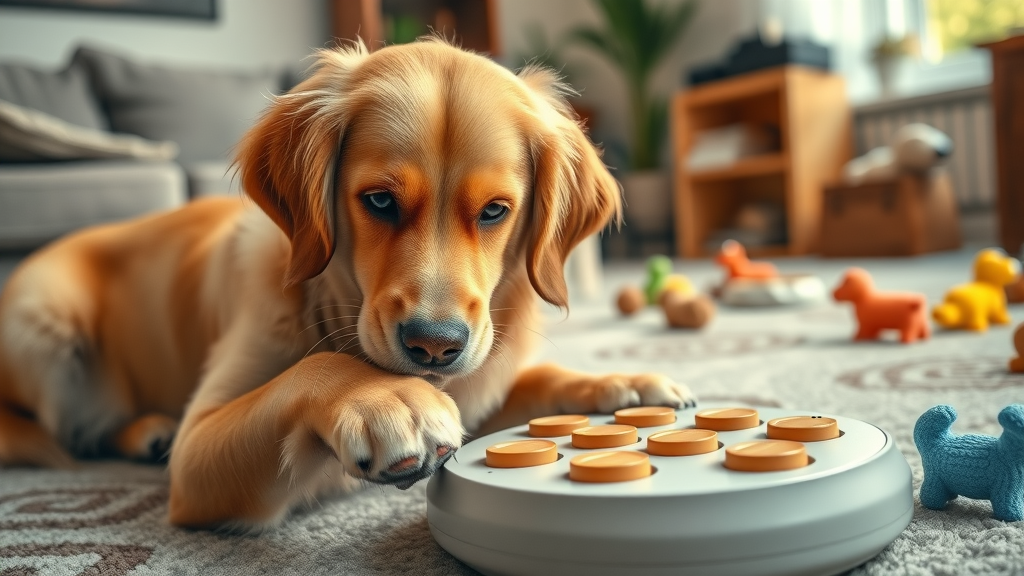
Are Indoor Dog Activities Enough to Satisfy Your Pup's Mind and Body?
When outdoor walks aren’t possible, many pet owners feel concerned about their dogs missing out—but today’s indoor dog activities offer plenty of ways to keep your pup mentally and physically satisfied. Indoor games and routines can rival even the dog park for stimulation, especially when you mix up the activities. The secret is combining mental stimulation with the right dose of physical exercise .
By using interactive toys , puzzle toys , or games like tug of war and hide and seek , you’ll discover that you can encourage your dog to exercise both body and brain within four walls. These activities work wonders for dogs of all ages and breeds, ensuring no day spent indoors needs to feel boring. With a commitment to creative play, you can easily keep your dog moving , focused, and happy—making every day together meaningful, regardless of what’s happening outside.
What You'll Discover About Indoor Dog Activities
- Explore why indoor dog activities are essential for mental stimulation, physical fitness, and overall well-being.
- Understand how you can easily implement these interactive routines at home and strengthen your bond with your dog indoors.
The Importance of Indoor Dog Activities for Keeping Your Dog Indoors Engaged
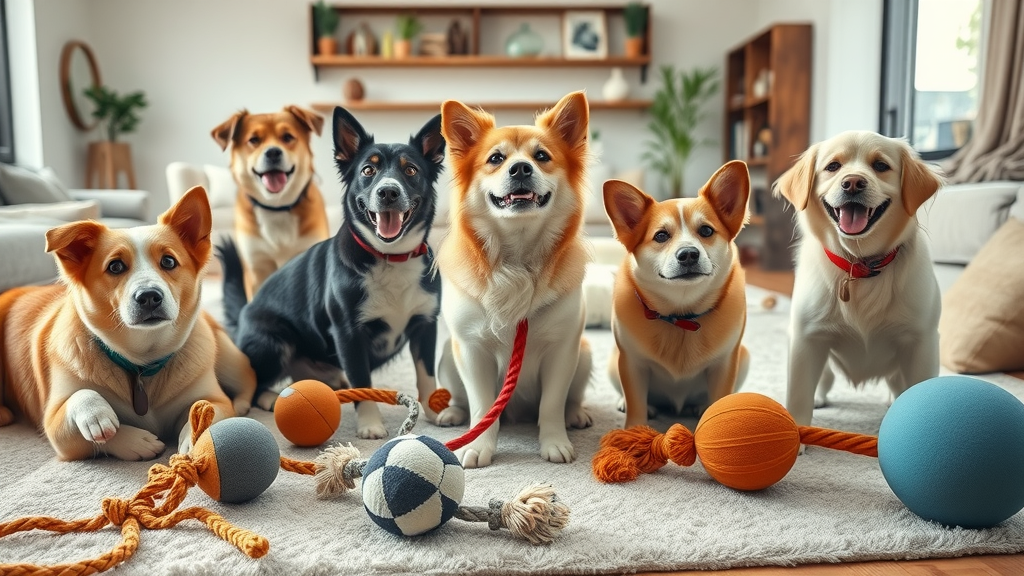
How Indoor Dog Activities Prevent Boredom and Unwanted Behaviors
Dogs crave mental stimulation and physical exercise , just like humans do. When left alone or without enough activity, a dog indoors can quickly become bored, which may lead to unwanted behaviors like chewing, barking, and digging. Smart dog owners know that the key to preventing indoor mischief is to offer varied and enriching activities that keep your furry friend thinking, moving, and entertained.
Regularly changing up dog activities not only stops boredom in its tracks but also strengthens your relationship with your pet. For instance, introducing a new puzzle toy or a fresh game of hide and seek can provide hours of focused fun and learning. Interactive play sessions mirror the valuable experiences of a dog park , stimulating your dog with the challenge of tracking down a favorite toy or solving a puzzle—minus the muddy paws.
“Active dogs are happy dogs—even within four walls, they need as much mental and physical exercise as outdoors.”
Why Every Owner Should Prioritize Indoor Dog Activities
Prioritizing indoor dog activities is about more than keeping your home intact—it’s about creating opportunities for lasting health and joy. Dogs that play, learn, and move around inside are more likely to display positive social behaviors, stay alert well into their senior years, and form a deeper bond with their humans. Especially for pet owners who can’t always access the outdoors, a robust routine of interactive toys , obedience drills, and games helps keep your companion both physically and mentally fit.
Whether you’re working from home or stuck inside due to weather, consistent indoor activities help your dog adjust to your daily rhythms. This routine provides predictable structure and a sense of purpose for both you and your pet, transforming “stuck inside” days into doggy day delight. When you ensure your dog is engaged—even when indoors—you’re not just preventing mischief; you’re boosting brainpower, building focus, and encouraging lifelong health.
Best Indoor Dog Activities: Fun Options for All Breeds
- Interactive toys and puzzle toys
- Tug of war games
- Flirt pole exercises
- Hide and seek with treats or toys
- DIY indoor agility courses
- Basic obedience training sessions
Keeping Your Dog Moving: Creative Indoor Dog Games
To keep your dog moving and entertained, it’s vital to balance mental challenges with physical movement. Practical games like tug of war , flirt pole chases , and indoor agility circuits provide a heart-pumping outlet and reinforce essential obedience skills. Create a regular schedule where you alternate between calm activities, like a new puzzle toy or practicing basic commands, and more energetic games to make sure your pup stays attentive and satisfied all day.
If your dog is especially energetic, incorporate short bursts of high-engagement play such as flirt pole games—which mimic the joy of chasing at the dog park —with quieter activities like scent-tracking or searching for items. Even a living room obstacle course can become a daily favorite; it’s fun, easy to customize to your space, and keeps your dog focused while you supervise or join in. The best part? All breeds, from tiny Chihuahuas to lively Labradors, can join in the fun!
| Activity | Supplies Needed | Engagement Level | Skill Focus |
|---|---|---|---|
| Puzzle Toy | Treat-filled puzzle | High | Problem-solving |
| Flirt Pole | Flirt pole toy | Medium | Chasing |
| Indoor Agility | Household objects | High | Coordination |
| Tug of War | Rope toy | Medium | Strength |
| Hide and Seek | Treats or toys | Medium | Scent work |
Mental Enrichment with Puzzle Toys and Interactive Toys
Puzzle toys and other interactive toys offer powerful ways to mentally stimulate your pup during indoor time. Dogs are natural problem solvers with a keen sense of smell, and challenging them with reward-based toys taps into their instincts. These toys don’t just pass the time—they build confidence, improve problem-solving skills, and reduce anxiety. Rotate through different puzzle styles to find what truly excites your dog, from treat-dispensing balls to advanced sliding puzzles.
Strategically using these toys not only entertains but also helps manage resource guarding and food-related stress. Try incorporating lick mats for additional soothing and enrichment—smearing peanut butter or yogurt on these mats provides a tasty puzzle and helps anxious pups calm down. No matter your canine companion’s size or breed, interactive play is a proven method for keeping your dog sharp, satisfied, and happy inside.
Choosing the Best Puzzle Toy to Challenge Your Pup Indoors
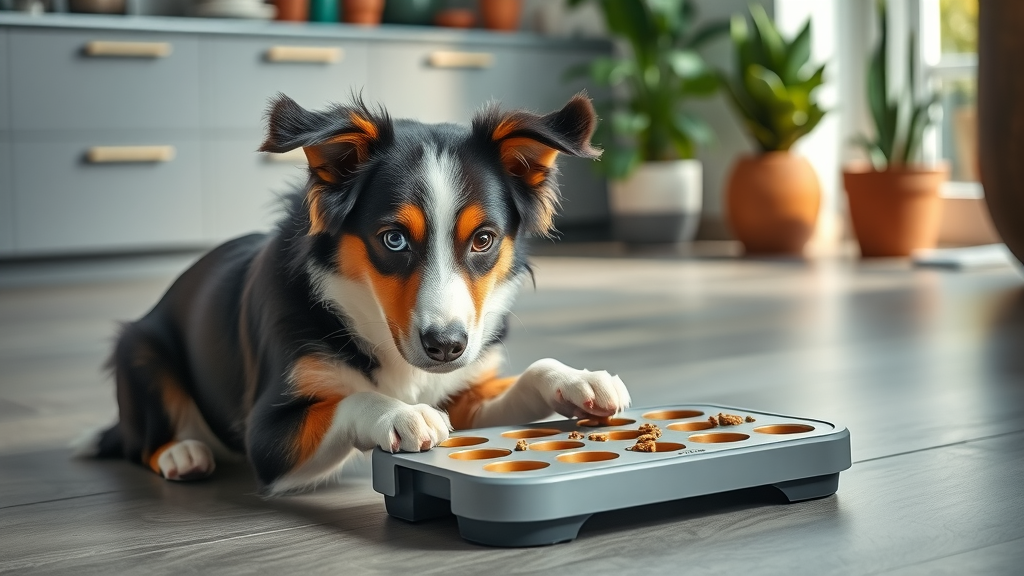
Picking the right puzzle toy depends on your dog’s abilities and interests. For dogs new to puzzles, start with simple treat balls or snuffle mats that encourage sniffing and gentle nudging. As your dog’s confidence grows, introduce more complex puzzles with sliding pieces, drawers, and levers to push or pull—these toys reward your dog’s patience and determination while keeping their brain busy. Make sure the toy is sturdy, safe, and easy to clean, especially for strong chewers!
Keep a few favorites on rotation to ensure the novelty never wears off and remember to supervise play, especially as your dog learns to manipulate new mechanisms. If your pet gets stuck, offer hints or use positive reinforcement —praise, encouragement, and treats—to help build persistence and success. Over time, these toys not only mentally stimulate but also foster independence and problem-solving skills vital for a happy dog indoors .
Interactive Toys That Offer Lasting Fun for All Dogs
Beyond classic puzzles, interactive toys like rotating treat dispensers, automated laser toys (used under supervision), and tug-a-rope machines transform your living room into an engaging play zone. These toys redirect excess energy and give your dog a goal to focus on, reducing unwanted behaviors like chewing or barking. Engaging toys promote health, learning, and independent play; plus, they make life easier for busy pet owners .
Always choose toys suited to your dog’s size and play style. For high-energy or working breeds, an interactive game that renews its challenge (or dispenses treats on a schedule) can be a lifesaver during long days inside. Changing toys regularly will prevent boredom and ensure these indoor games remain as exciting as a trip to the dog park .
Physical Indoor Dog Activities to Burn Energy and Beat Boredom
Even when you can’t take your dog outdoors , it’s important to introduce sufficient physical exercise indoors. Start with compact, energy-burning classics— tug of war ramps up strength and focus, while the flirt pole channels your pup’s chase instinct safely indoors. Both games allow you to practice basic commands (“drop it,” “leave it,” and “wait”) as you play, neatly combining obedience training with active fun.
If your dog craves variety, switch between short chase games and agility activities using safe, household items; think chairs for weaving, blankets for crawling, or towels for jumping practice. Not only does this keep your dog’s body in motion, but it also helps build coordination and focus. When you run short on space, break up exercise into brief, frequent sessions—this approach burns just as much energy as a longer walk, leaving your pup happily tired.
Tug of War and Flirt Pole: Engaging Play for Every Indoor Dog
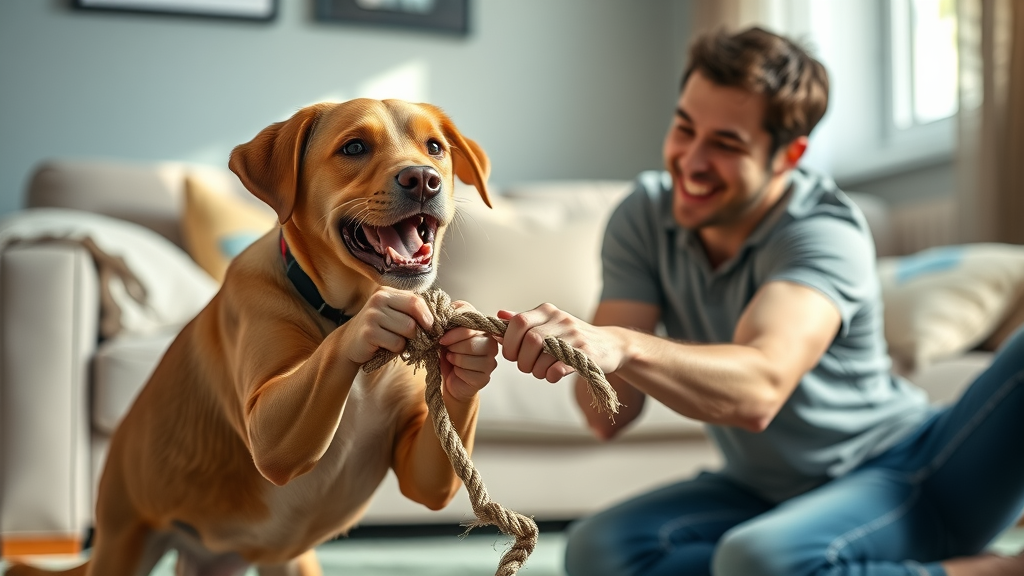
The classic tug of war is more than a game—it’s a joint workout and a lesson in self-control. Before you start, set some ground rules: only tug on cue, and let go when asked. This ensures tug of war remains safe and enjoyable for everyone, teaching your dog to listen, wait, and release on command. It’s a fantastic, interactive way to tire your dog indoors , promote healthy play habits, and build trust.
For dogs that love to chase, the flirt pole is a must-have. It’s simply a long pole with a rope and toy at the end, allowing your pet to chase and pounce safely in a small space. Flirt pole sessions ( short bursts of running, twisting, and jumping ) mimic a hunting scenario and are ideal for high-intensity exercise—plus, it creates space for practicing commands like “wait” and “drop it” even amid excitement. Combining these games ensures your dog moving indoors never feels like a chore.
Setting Up an Indoor Agility Course: Step-by-Step Guide
- Plan your course : Choose a safe, open space (living room, hallway, or basement) free of breakables.
- Select household objects to use as hurdles (cushions), weave poles (brooms, cones), and tunnels (blankets draped over chairs).
- Map out the sequence : Arrange obstacles to encourage your dog to weave, jump, crawl, and balance in a circuit. Keep distances manageable but challenging.
- Use positive reinforcement : Guide your dog through at a slow pace, rewarding each success with treats, praise, or a quick game with a favorite toy .
- Increase difficulty : Once your pup learns each obstacle, rearrange the course or introduce new ones to maintain excitement and challenge.
Not only does this setup foster coordination and obedience training , but it also breaks up dull afternoons, giving your dog a legitimate reason to zoom, bounce, and learn—even inside!
Teaching Tricks and Obedience Training: Efficient Use of Indoor Time
Rainy days or busy schedules are the perfect chance for dog training that goes far beyond “sit” and “stay.” Teaching a mix of basic obedience and advanced cues keeps your dog’s mind engaged, especially when paired with treats or interactive rewards. Obedience training inside challenges your pup’s focus amid home distractions and is a cornerstone for a well-mannered companion.
Establish a daily lesson—even 10–15 minutes is enough to help your dog master new skills or polish up on manners. Positive, upbeat sessions using your furry friend’s favorite treats or toys ensure training is fun, not a chore, and allow you to confidently manage behavior both indoors and out.
Basic Obedience and Advanced Cues for Brainy Dogs
Don’t stop at the basics; mix in cues like “place,” “touch,” or “spin” to keep your brainy dog guessing. These commands push your pet to think more creatively and can be practiced in small spaces using mats, targets, or obstacle props. Complex tricks or even scent games—such as identifying distinct toys by name—teach your dog to solve problems and listen, giving them a job even while indoors.
Use each session to reinforce old skills while introducing one new behavior. This gentle balance of repetition and challenge energizes your dog’s mind and lays a foundation for a lifetime of learning. Considering how easy it is to squeeze in a few short training moments a day, teaching new skills is one of the most efficient—and rewarding—ways to spend time together inside.
Fun Ways to Teach Your Dog New Skills Inside
Turn every corner of your home into a mini-classroom. Use furniture and props to “target” jump or touch, teach your dog to find specific items by scent, or reinvent old tricks with different cues. Vary rewards—sometimes treats, other times a tug session or praise. Whether you’re showing your pet to ring a bell for bathroom breaks or balance on a cushion, these challenges keep your dog entertained and excited to team up with you.
Training sessions provide structure and routine, two elements that are vital for a happy, healthy indoor dog . Plus, they’re a creative way for both you and your dog to beat cabin fever and climate whatever’s happening outdoors!
Hide and Seek: A Classic Indoor Dog Activity for Instinct and Focus
Hide and seek is an ideal game for indoors: it sharpens your dog’s sense of smell , pays tribute to natural hunting instincts, and builds focus. Place your dog’s favorite toy or favorite treat in a tricky spot, then encourage your pup to sniff it out. This game offers the excitement of a dog park scent challenge—without ever leaving the house.
Playing hide and seek together not only strengthens the bond you share but also provides a low-impact activity on days when your dog needs mental but not physical exertion. Get the entire household involved and take turns hiding, turning your home into a playful maze of delightful discoveries.
Fun Variations of Hide and Seek for Dogs Indoors
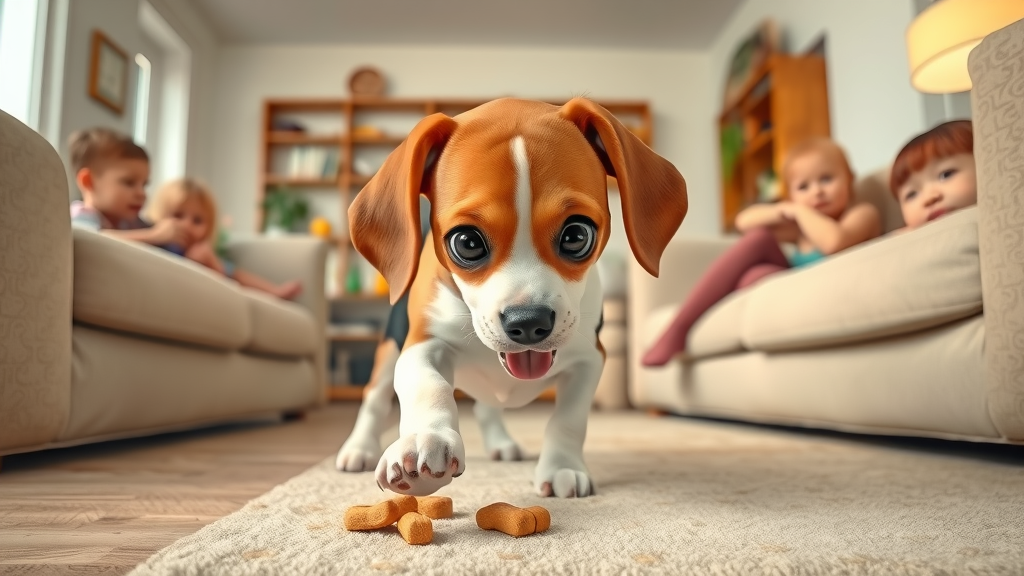
Keep hide and seek fresh with creative twists. Try hiding multiple treats across a few rooms, making the search last longer and rewarding your dog each time they “find it.” Introduce distractions or easy obstacles like pillows or tunnels for an extra challenge. You can even hide yourself—call your dog from another room and celebrate when they find you, transforming this classic game into a true test of loyalty and love.
Some dogs adore searching for certain objects (a ball, a squeaky toy), while others thrive on scent-based challenges. Mix up the items and locations each week, and don’t forget to cheer your pup after each win—the goal is scent work success and plenty of tail-wagging enthusiasm!
How to Entertain Your Dog Indoors: Practical Tips and Popular Ideas
Entertaining your dog indoors is easier than you might think. Focus on variety: switch between active games, quiet reward puzzles, obedience drills, and scent-based challenges. For best results, keep a checklist of all the activities and rotate through them for novelty and ongoing excitement. Short, frequent play sessions trump long, repetitive ones, ensuring your dog stays motivated and engaged even during gloomy weather.
Don’t forget the power of routine; a simple schedule with planned playtimes lets your dog anticipate fun, reducing anxiety and creating positive associations with being indoors. Stock up on puzzle toys , rope toys, and safe chew items, and recruit your family to join in on games—everybody gets exercise and the fun is multiplied.
What is the 7 7 7 Rule for Dogs? Understanding Structured Routine
A well-structured routine is a life-changer for both pet and owner. The 7 7 7 rule encourages you to offer three unique, focused activities each day: 7 minutes of sniffing , 7 minutes of interactive play (like flirt pole or fetch), and 7 minutes of mental challenges (like puzzle toys or new skills). The format is simple, short, and easy for any schedule, maximizing the balance between physical and mental enrichment.
For busy days, this rule ensures you never skip the essentials—and for active dogs, it gives a structured way to break up large blocks of time indoors. Over time, you’ll likely discover a calmer, happier dog that’s less prone to boredom-driven mischief.
Applying the 7 7 7 Rule to Indoor Dog Activities
Start your day with a treat-search around the house to allow for sniffing. After breakfast, schedule an energetic flirt pole or tug of war game, ensuring your dog moving and burning energy. Later, before dinner, offer a puzzle toy or short obedience training lesson to engage your dog’s brain. Rotating through these three core categories—physical, mental, and scent-based play—covers all of your dog’s indoor needs and leaves little time for boredom or trouble.
Flexibility is key; swap activities in and out to match your dog’s energy and interests, but keep the 7 7 7 structure as a reliable foundation. Over time, your indoor dog will adjust beautifully and thrive on the consistent, positive engagement!
Top Ways To Keep Your Dog Entertained Inside
- Rotate puzzle toys and interactive toys to avoid repetition
- Create an indoor scavenger hunt with favorite treats
- Set daily indoor agility challenges
- Teach your dog a new trick each week
- Combine tug of war and flirt pole for dynamic play
Do Indoor Dogs Get Bored & How to Prevent It with Activities
Yes, indoor dogs can get bored if not given enough mental stimulation and physical exercise . Symptoms include chewing, barking, or restlessness. But the good news: indoor dog activities provide a practical and reliable way to keep canine boredom at bay. Rotate through fresh games and toys, and never underestimate the power of routine and interactive play.
Prevention is always easier than solving a behavioral issue down the line. If you see warning signs—such as destructive chewing or excessive licking—add more interactive toys , scent games, or new skills to your daily rotation. A satisfied, engaged pet means less stress for you and a happier home for everyone.
Signs of Boredom and Solutions with Indoor Dog Activities
Watch for signals like pacing, whining, excessive licking, or chewing on inappropriate objects. If your dog exhibits these, introduce new activity rotations: increase puzzle toy difficulty, add hide and seek games, consider a new basic obedience command, or allow extra time with lick mats . The goal is to keep your furry friend physically and mentally challenged so that restlessness turns into contentment.
Regular, structured playtime mixed with independence-building puzzles will help transform negative energy into focused fun—a win-win for your pup and your home environment.
Common Questions About Indoor Dog Activities
How to entertain your dog indoors?
You can entertain your dog indoors by utilizing interactive toys, puzzle toys, tug of war, and hide and seek games. Regularly rotating activities and teaching new tricks will keep your dog's mind and body active.
What is the 7 7 7 rule for dogs?
The 7 7 7 rule encourages dog owners to provide 7 minutes of sniffing, 7 minutes of interactive play, and 7 minutes of mental challenges each day, which can be perfectly tailored with indoor dog activities.
What can I do inside with my dog?
Inside your home, you can set up agility obstacles, play tug of war, experiment with puzzle toys, or organize an indoor scavenger hunt to fully engage your dog.
Do indoor dogs get bored?
Yes, without enough indoor dog activities, dogs may get bored, leading to undesirable behaviors. Providing a variety of engaging activities prevents boredom and supports well-being.
Video Guide: Engaging Indoor Dog Activities for Every Day
Key Takeaways for Successful Indoor Dog Activities
- Consistency is key—make indoor dog activities a regular part of your dog's routine
- Mix mental and physical challenges to suit your dog's breed and personality
- Monitor your dog for signs of boredom or overexcitement and adapt activities as needed
Final Thoughts: Building a Happy, Healthy Relationship With Indoor Dog Activities
“A fulfilled mind and body make for a happy, well-behaved companion—even on the rainiest days.”
Video Walkthrough: Setting Up Fun Indoor Dog Activities In Minutes
Ready to Make Your Pup’s Day? Start These Indoor Dog Activities Now
Keep your pup happy, healthy, and engaged—discover fun, easy activities for dogs that boost bonding, burn energy, and beat boredom every day!
To further enhance your understanding of indoor dog activities, consider exploring the following resources:
-
“Fun Indoor Games to Play With Your Dog” by the American Kennel Club offers a variety of engaging games designed to keep your dog mentally and physically stimulated indoors. ( akc.org )
-
“12 Indoor Exercises for Dogs When You Can’t Get Outside” by PetMD provides a comprehensive list of exercises to help your dog stay active and healthy indoors. ( petmd.com )
These resources offer practical tips and creative ideas to ensure your dog remains happy and engaged, regardless of outdoor conditions.
 Add Row
Add Row  Add
Add 


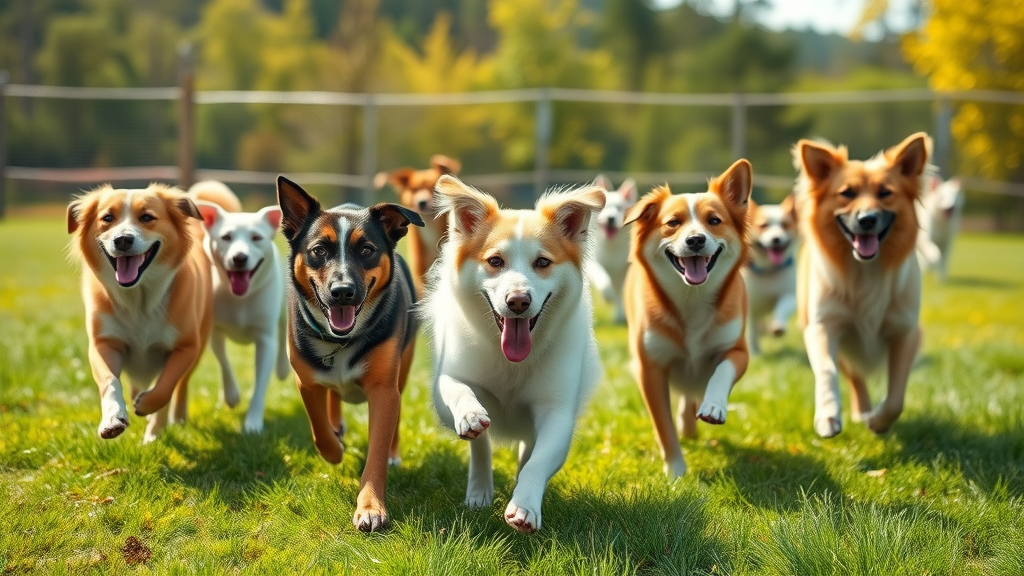

Write A Comment